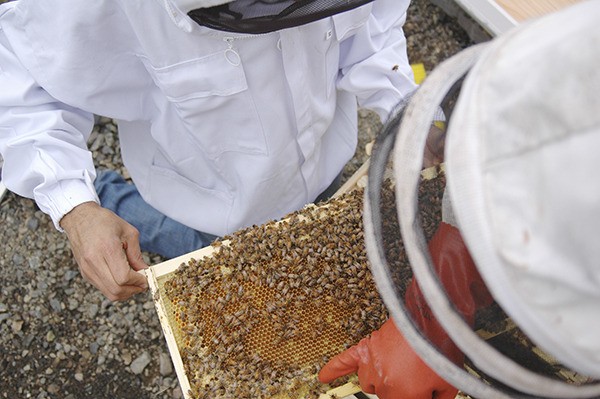Tyrone Tidwell and his partner currently are reading “Honeybee Democracy” in an attempt to better understand their latest endeavor — beekeeping. Since the end of April, Tidwell has been trying his hand at raising honeybees for the first time.
Just outside his back door sit two new, shiny white beehives. The beehive known as the “pink hive” has pink flowers painted on its front and same goes for the “purple hive.” Each beehive houses its own colony of honeybees and although only a couple feet separate the two beehives, each honeybee keeps to its own hive.
“Beekeeping is so interesting,” Tidwell said.
“I guess you could say their intelligence is one of the most fascinating parts.”
Complex societies
Honeybees are a female-based society, Tidwell explained. Each beehive has thousands of female worker bees, a few drones (male bees) and one queen bee. Unlike the native bee species the bumblebee, honeybee colonies can have thousands of individuals.
Because the worker bees only have about six weeks to live, their life cycle is separated into different roles, longtime beekeeper and member of the North Olympic Peninsula Beekeepers Association (NOPBA), Mark Urnes explained. Different segments of a worker bee’s life is devoted to tending to the queen bee, tending to the eggs and larva, building honeycomb (the structure made from wax produced by the bees’ wax glands) or scouting for pollen and water to bring back to the hive.
Bees transporting pollen and water back to hive are in their final stages of life, Urnes explained.
The drones on the other hand have one purpose: reproduce with the queen bee. Once the drones are no longer needed the worker bees kick them out of the hive. A queen bee is able to lay 2,000 eggs per day. She also has the longest lifespan of two to three years, although the queen cannot fly or leave the hive and therefore relies on her workers to bring her nutrients and water.
Challenges of PNW beekeeping
Despite the large quantity per colony, raising honeybees around here is not for the faint of heart.
Every year about “one-third of the hive is lost,” Urnes said.
As one of the goals of the Beekeepers Association, Urnes helps new beekeepers like Tidwell get their bees established and acts as a sort of “bee mentor.”
Urnes explained there is no real answer to the seemingly high annual die-off, but ever since the varroa mite was introduced in the 1980s and wiped out most of the wild honeybees, the bees have been struggling to regain their numbers and health.
“Keeping your bees alive is probably one of the most challenging parts of beekeeping around here,” Urnes said.
Unlike warm dry climates, like California for example, the Olympic Peninsula is fairly wet and cold and thus has a short season because honeybees need relatively nice weather to fly and scout for pollen and water.
“One problem for new colonies is having a reliable weather pattern,” Urnes said.
However certain races of honeybees are more adapted to the cooler climates than others. Tidwell’s honeybees are of the “carniolan” race.
Because of the shorter season, honeybee hives here produce far less honey than in places like California, but Tidwell still should expect about 3-5 gallons per hive come next September.
Bees make honey to fulfill their carbohydrate needs throughout the year and especially through the winter months. The honey extracted by the beekeeper at the end of the season is essentially the extra honey not needed by the bees.
An old tradition
Although the honeybees’ season may be short around here, beekeeping is a long-standing practice. Honeybees were introduced into North America in the early 1600s, but it wasn’t until fairly recently that honeybees inhabited the western United States, Urnes said. By the 1850s honeybees finally had made their way to California.
Because of the long interaction between humans and honeybees, beekeeping knowledge and practices date far back in human history. Tidwell is even finding many of the old beekeeping practices are still consistent with current beekeeping.
“It’s interesting reading historic information on beekeeping and finding the same tools and techniques are still being used in modern beekeeping,” Tidwell said.
Between following the tried and true beekeeping techniques and advice from Urnes, Tidwell’s honeybees appear to be off to a good start. Within the next week or two Tidwell anticipates being able to add additional boxes to his existing beehives to provide more room for the bees and encourage them not to swarm.
For more information on beekeeping or the North Olympic Peninsula Beekeepers Association, visit www.nopba.org.
Reach Alana Linderoth at alinderoth@sequimgazette.com.


